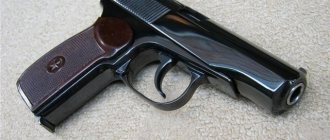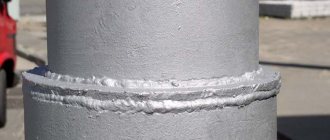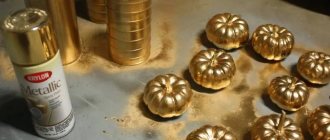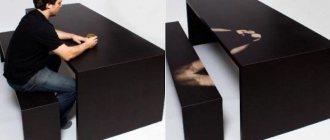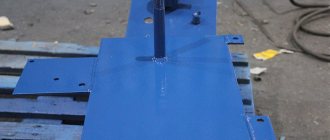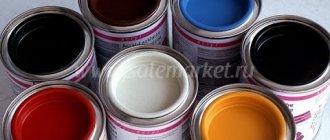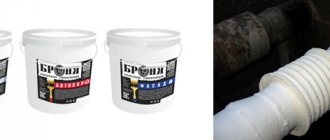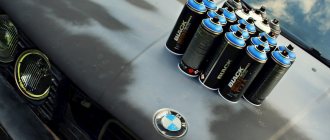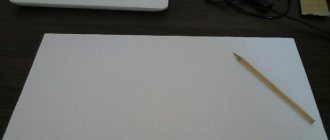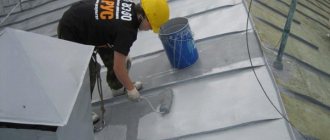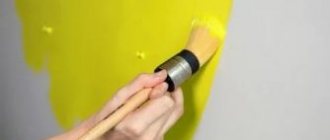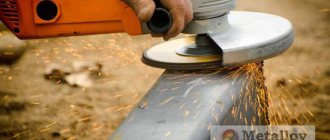Recommendations for applying “HAMMERITE” paint
In the open air and in contact with moisture, unprotected metal becomes covered with iron oxide - rust. If measures are not taken in time, the process will continue until the surface is completely corroded by rust. To prevent the appearance of rust, a durable protective coating is needed that prevents the penetration of oxygen and moisture. For these purposes, the English company “Hammerite” developed a paint that received a similar name.
Hammerite paint is based on modified alkyds with the addition of styrene, which provide the best adhesion to steel surfaces. Hammerite also contains fast-evaporating solvents, which promotes rapid drying and reduced drying time between coats. Silicones included in the paint enhance water-repellent properties, and tempered glass particles create a waterproof barrier. Hammerite paint comes in glossy, matte and hammer finish (crimp). There is no difference in composition between matte and glossy paints. Hammer paint contains aluminum flakes, which create a characteristic “patterned” pattern. Hammer enamel contains special silicones that stabilize the “patterned” pattern and provide a water-repellent effect.
Hammerite paint is used as an anti-corrosion and decorative coating. Applicable to ferrous and non-ferrous metals. Hammerite paint is ideal for rusty surfaces.
To apply to a rusty surface, it is necessary to remove the loose layer of rust and ingrained dirt (for this it is best to use a metal brush), degrease and apply the paint according to the instructions on the can.
When applying to new metal, the surface must be thoroughly prepared before painting. Such metal has a factory lubricant that protects it from corrosion, which must be removed. Using a greasy solvent (solvent or white spirit), rinse the surface 2-3 times, and then use a volatile solvent - acetone. The quality of cleaning can be checked using filter or blotting paper from a regular student notebook. If there are no greasy stains left on the paper, the surface is ready for painting.
Shiny and smooth metal surfaces must be sanded first to create maximum adhesion. To do this, you can use small metal brushes or sanding paper R-40, R-60.
Hammerite paint can be applied over old paintwork, as it is compatible with almost all paintwork materials (alkyd, acrylic, urethane, silicone, etc.), with the exception of bitumen-based materials. To do this, you need to remove the remaining particles of old paint with a fine metal brush and thoroughly rinse the entire surface with a solution of washing powder (or other detergent) to remove dust, dirt, stains, fats and salts. Then rinse the surface again with clean water and air dry.
Hammerite paint is also suitable for painting galvanic coatings. To do this, apply For Galvanised Metal Surfaces primer before painting.
For painting products made of aluminum and non-ferrous metals, Hammerite Special Metal Primer is first used.
When painting wooden surfaces, you must first treat the entire surface with acrylic water-thinned primer or Hammerite's Anti-Rust No. 1 primer. It is not recommended to apply Hammerite paint directly to wood.
When painting welds, they must first be primed with Hammerite Special Metal Primer, and then Hammerite paint must be applied using any method.
Particular attention is paid to the surface preparation stage, since it accounts for 90% of the success of painting.
“Hammerite” paint differs significantly from all known materials in its protective properties and, most importantly, curing time.
Hammerite paint dries quickly in air (20 - 30 minutes), but complete curing occurs after 6 weeks (although protective properties appear after 3 hours). Therefore, it is necessary to strictly observe the paint application modes and parameters.
Recommendations for applying HAMMERITE paint
Recommendations for applying “HAMMERITE” paint
In the open air and in contact with moisture, unprotected metal becomes covered with iron oxide - rust. If measures are not taken in time, the process will continue until the surface is completely corroded by rust. To prevent the appearance of rust, a durable protective coating is needed that prevents the penetration of oxygen and moisture. For these purposes, the English company “Hammerite” developed a paint that received a similar name.
Hammerite paint is based on modified alkyds with the addition of styrene, which provide the best adhesion to steel surfaces. Hammerite also contains fast-evaporating solvents, which promotes rapid drying and reduced drying time between coats. Silicones included in the paint enhance water-repellent properties, and tempered glass particles create a waterproof barrier. Hammerite paint comes in glossy, matte and hammer finish (crimp). There is no difference in composition between matte and glossy paints. Hammer paint contains aluminum flakes, which create a characteristic “patterned” pattern. Hammer enamel contains special silicones that stabilize the “patterned” pattern and provide a water-repellent effect.
Hammerite paint is used as an anti-corrosion and decorative coating. Applicable to ferrous and non-ferrous metals. Hammerite paint is ideal for rusty surfaces.
To apply to a rusty surface, it is necessary to remove the loose layer of rust and ingrained dirt (for this it is best to use a metal brush), degrease and apply the paint according to the instructions on the can.
When applied to new metal
It is necessary to carefully prepare the surface before painting.
Such metal has a factory lubricant that protects it from corrosion, which must be removed. Using a greasy solvent ( solvent or white spirit
), rinse the surface 2-3 times,
and then use a volatile solvent - acetone
. The quality of cleaning can be checked using filter or blotting paper from a regular student notebook. If there are no greasy stains left on the paper, the surface is ready for painting.
Shiny and smooth metal surfaces must be sanded first to create maximum adhesion. To do this, you can use small metal brushes or sanding paper R-40, R-60
.
Hammerite paint can be applied over old paintwork, as it is compatible with almost all paintwork materials (alkyd, acrylic, urethane, silicone, etc.), with the exception of bitumen-based materials. To do this, you need to remove the remaining particles of old paint with a fine metal brush and thoroughly rinse the entire surface with a solution of washing powder (or other detergent) to remove dust, dirt, stains, fats and salts. Then rinse the surface again with clean water and air dry.
Hammerite paint is also suitable for
coloring
of galvanic coatings
.
To do this, apply For Galvanised Metal Surfaces primer
.
For painting products made of aluminum and non-ferrous metals, Hammerite Special Metal Primer is first used.
When painting wooden surfaces, you must first treat the entire surface with acrylic water-thinned primer or Hammerite's Anti-Rust No. 1 primer. It is not recommended to apply Hammerite paint directly to wood.
When painting welds, they must first be primed with “Hammerite Special Metal Primer”,
and then apply Hammerite paint using any method.
Particular attention is paid to the surface preparation stage, since it accounts for 90% of the success of painting
.
“Hammerite” paint differs significantly from all known materials in its protective properties and, most importantly, curing time.
Hammerite paint dries quickly in air (20 - 30 minutes), but complete curing occurs after 6 weeks (although protective properties appear after 3 hours). Therefore, it is necessary to strictly observe the paint application modes and parameters.
The paint is applied in several layers (depending on the application method and the surface - from 2 to 5 layers
). Each subsequent layer is applied after 20 - 30 minutes, but no later than after 3 hours, since after this the paint curing process begins and the next layer can be applied no earlier than after 6 weeks.
Application modes and parameters
Hammerite paint can be applied at temperatures from 10°C to 25°C
, while air humidity should not exceed 85%. The paint can be applied by spray, brush, roller, aerosol and air spray.
Spraying is used when painting large surfaces. When spraying Hammerite paint, you should select the correct viscosity. The instructions give a ratio of paint and solvent “Brush Cleaner & Thinners” of 2:1. This relationship is true at temperature t° = 18-22°C
.
At temperatures above 23°C, it is better to choose the viscosity for yourself
(i.e., taking into account the spray pressure, paint consumption and your skill).
As a rule, in this case, solvent will have to be added, otherwise cobweb formation will be observed both on the surface to be painted and on the spray nozzle. At temperatures below 17°C, paint may run off the surface
; in this case, it is necessary to reduce the amount of solvent.
In the absence of a device for determining viscosity - a viscometer, viscosity can be determined “by eye” as follows: pour the required amount of paint into a clean jar, add a little solvent, mix the paint with a wooden stirrer; With each new portion of solvent, raise the stirrer above the can to determine whether the paint breaks after 2-3 seconds of bleeding from the stirrer.
“Hammerite” paint is applied in 4 layers and allowed to sit for 20-30 minutes between coats
.
For best results, apply the 1st coat very, very thinly.
, practically apply a spray, wait for 2-3 minutes and then apply subsequent layers.
The last layer should be as thick as possible
, but just enough so that there are no smudges or sagging on the surface to be painted. (When working with hammer paints, you should pay special attention to this.)
2. Application with a brush.
It is used on small flat surfaces and for painting iron fences of complex configuration. Apply 2-3 layers
.
It is necessary to pay special attention to the painting of edges and corners, since corrosion begins there first. When working with complex and vertical surfaces, it is better to apply paint in several thin layers (5 - 6)
.
However, we must remember that the total thickness must be at least 100 microns. It is better to use “fleece” brushes
made of natural bristles.
3. Application with an aerosol can.
Apply at least 4 layers
. Used on small surfaces and for touch-up painting.
Before starting work, you need to shake the can for 3 minutes after you hear the sound of the mixing ball. The paint is applied to the surface in thin layers (since there is no way to control the flow and supply of paint) from a distance of 15-20 cm. The first layer is very, very thin, wait for 2-3 minutes and subsequent full layers with a wait between layers for 15-20 minutes. The total thickness of the dried coating is at least 100 microns. (The average layer thickness when applied with an aerosol can is 20-25 microns.)
Apply 2-3 layers
.
Used when painting large flat surfaces. Before starting work, you need to dilute the paint with “Hammerite Brush Cleaner & Thinners” solvent in a ratio of 9:1
(9 parts paint to 1 part solvent).
It is better to use a short-haired fur or wool roller. First, paint is applied to the corners and edges (you can use a brush for these purposes), and then the rest of the surface is painted over with a roller.
Types of thinners used
There are several groups of popular thinners used by professional artists. These include compositions made on the basis of vegetable oils, varnishes, as well as doubles, tees and pinene.
- Oil.
Common vegetable oils of various origins, such as linseed, poppy, sunflower, hemp, have long been used by artists for diluting paints. - Varnishes are made on the basis of diluted resins.
When used as a thinner, the paint structure becomes denser and promotes better adhesion to the canvas. Special varnishes are made to be added to thinners to thin oil paints. - Double and tee.
As the name suggests, a double is a diluent containing two components. These components are varnish, as well as vegetable oils, composed in proportions that artists often select on their own. In the tee, a thinner is added to the above components. - Pinen.
Otherwise it is called “thinner No. 4”. It is used to dissolve and dilute compounds.
Pinen
Construction oil paints can be thickly grated or ready for use. Thickened paints must be diluted with a liquid specially designed for this purpose - a solvent. Oil paints are also mixed with a solvent if they have dried out over time or if they are planned to be used as a primer. Thinners are selected in accordance with the characteristics of the surface to be painted and its absorbent properties.
chemicals
- White spirit is the most common liquid.
- Purified and unrefined turpentine is used to thin many paints and varnishes. With purified turpentine, the drying time of the paint decreases; with unrefined turpentine, on the contrary, it slows down.
- Kerosene is great for restoring old oil paints. Along with kerosene, it is mandatory to add a drier - turpentine, for example. The disadvantage of this thinner is the increase in drying time - up to 10 days.
- Gasoline: its use gives the paint a matte finish. This option is used in construction to dilute thickly rubbed paint and varnish coatings.
paint and varnish material
- On a combined or composite drying oil, the production of which is not regulated by state standards. This coating is unsafe for use in houses and apartments: it contains harmful and toxic substances that continue to emit an unpleasant odor long after drying. Designated as MA-025.
- Natural drying oil based on vegetable oils - flaxseed, soybean or sunflower. Contains 97% natural ingredients and 3% drier. The paint is labeled as MA-021. Paints based on natural drying oil are used for painting surfaces in residential premises: walls, windows, doors, etc.
- Artificial glyphthalic drying oil, a substitute for natural. On the packaging it is designated as GF-023.
- On pentaphthalic drying oil - PF-024, which half consists of natural oils with the addition of glycerin, drier and phthalic anhydride.
exterior finishing
Applied oil paints have not only decorative value, they protect surfaces from moisture, corrosion and rotting processes, and also serve as a barrier to external influences. Diluted oil paint is successfully used as a primer base, which will serve as a binding material.
Oil paints are pigments of various colors, ground to a powder, which are then mixed with an oil base into paint of the desired consistency and thickness. so called because these paints are based on linseed oil.
Due to the fact that oil has water-repellent properties, it is not possible to mix and dilute these paints like watercolors or acrylics with water. Special solvents based on oil, white spirit and pinene allow you to reduce the concentration of pigment or mix different paints with each other. The chosen thinner may also determine the preservation of the quality of the written work.
Composition and properties of paint
Hammerite paint is made on the basis of inorganic pigments, the peculiarity of which is the absence of lead. Silicone, which is part of the product, improves water-repellent properties, glass microparticles create a waterproof barrier, and quickly evaporating solvents significantly accelerate interlayer and complete drying.
Properties of paints
- give painted surfaces a spectacular and original appearance, since the colors of the product are distinguished by a wide range of both primary and additional shades;
- have good adhesive properties, including rust that remains after all the necessary preparatory manipulations intended for metal. This determines the long service life of the paint layer;
- resistant to temperature changes, withstands well the range from -20 to +85°C, but even if hammerite paint has been briefly exposed to higher temperatures (up to 150°C), it will still retain its positive qualities;
- no changes in the coating after exposure to ultraviolet radiation and other external factors - this applies to both metal, wood and other types of surfaces;
- protection of plastic products.
What kind of paint can be used for a spray gun?
With this device you can spray any liquid substances. The main thing is that the composition is not too thick and does not clog the nozzle of the device. Today on the shelves of hardware and construction stores you can find many mixtures for painting wood, glass, and metal.
All of them are combined into five groups, from which various derivatives are obtained.
- Alkyd enamel is made from alkyd resin. The material mixes well with other compounds and dries quickly. Used for finishing wooden, metal, concrete surfaces. Can act as an anti-corrosion primer.
- Acrylic paint is based on ester polymers. It is used during construction work and for painting wooden, metal, plasterboard products and surfaces.
- Water-based paint is the most inexpensive and practical finishing material. The basis of the material is polymers mixed with water and coloring pigment.
- Oil paint is a combination of drying oil and pigment. The compositions are highly toxic, however, they stand out in rich, bright colors.
- Nitroenamels are made from nitrocellulose varnish combined with a coloring pigment. Especially often used in metal finishing.
Each composition has its own characteristics and characteristics, the most important of which is the level of viscosity. In order to properly prepare paint for a spray gun, it is advisable to measure the viscosity of the mixture and use solvents to bring this indicator to the desired value.
Types of hammerite paints
There are the following types of enamel:
- Hammer. In addition to the main components, this paint contains aluminum shavings, which gives the painted surface the appearance as if it had been beaten with a hammer. This feature helps create the now fashionable “aging effect” on a variety of interior items, and is also used for processing metal products - fences, fences, industrial equipment, etc. Main characteristics:
- high degree of adhesion to rust;
- increased hydrophobicity;
- quick drying;
- variety of shades.
- Smooth, compares favorably with coloring compositions from other manufacturers with the following advantages:
- the composition includes active anti-corrosion components, thanks to which hammerite paint provides long-term protection against rust;
- can be applied to areas affected by corrosion;
- high degree of adhesion and good hiding power;
- has a “3 in 1” effect - can be used as a primer, sublayer and finishing layer;
- easy to apply;
- dries quickly;
- the ability to create a glossy or semi-matte texture.
Regardless of the type, hammerite paints are suitable for protecting, decorating and giving the desired color to both metal surfaces and wood, glass, and plastic.
Making your own hammer paint
Soviet reference books contained materials on creating hammer enamel on your own. This has a very mediocre relation to modern materials, but if the starting materials are available, the operation can be carried out right in the garage. To create enamel, the following substances are required:
- Soot in an amount from 0.2 to 0.5% of the total mass;
- 93.5-96.8% - UVL-3 or UVL-1 varnish (viscosity according to NIILC instruments and room temperature - 8-12 sec);
- 3-6% – aluminum shavings.
Soot affects the relief and color of the material - in inverse proportion, the amount of aluminum contained in the enamel affects the pattern. The mixture of these three components is thoroughly mixed (in the factory - 3 hours with a stirrer at 200 rpm). Mixing ends when the aluminum shavings stop floating (the fat film dissolves). The color is set by adding no more than 30% colored enamel to the initial mass.
This hammer enamel must be diluted before applying to the car with silicone oil (literally a few drops are required on the spray tank). The oil is thoroughly mixed with the substance and its dissolution is immediately followed by the precipitation of suspended particles from it, due to which the embossed pattern is formed. Therefore, immediately after adding oil to the enamel, you need to proceed to painting the car.
Advantages and disadvantages
All coloring products of this brand have a number of undeniable advantages:
- creates a reliable water- and dirt-repellent layer;
- prevents the development of corrosion processes;
- all processes associated with surface cleaning and painting do not require special preparation, so the consumer can perform them independently, thus saving money on the services of professionals;
- the ability to use tools available to most people for painting;
- minimum expenditure of time and effort during preparation and painting, including rust;
- fast drying, which significantly saves time - each subsequent layer can be applied within three hours after the previous one. In addition, three hours after applying the last layer, the painted object is allowed to be used;
- does not have an unpleasant odor or toxic effect on the human body, which is very important when performing interior painting work;
- colors and textures are so varied that they will satisfy the whims of even the most capricious buyer.
Negative aspects associated with violating manufacturer's recommendations
Sometimes consumers complain about low-quality products, without taking into account that all the positive aspects of hammerite paint appear only when it is used correctly. The most common problems include:
- After applying the product to the rust spots, they soon appeared again. Possible reasons:
- poor quality cleaning and drying (in case of pre-washing) of the product;
- poorly or not cleaned edges of the product, as well as its hard-to-reach areas. The rust remaining in these places very quickly reminds itself;
- saving paint. The manufacturer recommends two-layer application. Therefore, even if it seems that one coat is enough and the surface looks perfect, a second coat should be applied. Having saved a small fraction, you will then have to spend a lot on repeated cleaning, processing and preparation, as well as on the purchase of additional paint and varnish material and painting.
- The painted metal surface has become wrinkled and uneven. Most likely, this happened due to haste, as a result of which the interval for drying the previous layer was not maintained.
- Small delaminations form on the surface treated with hammer paint. This situation is associated with the poor adhesive properties of the painted material - aluminum, galvanized steel and other non-ferrous metals are very smooth and require priming before the painting process. Therefore, it is very important to initially pay attention to the material from which the product is made.
Tools for painting car bodies and other structures
To paint the vehicle body or other structures and parts, you can use various special tools available. Smooth Hammerite enamel lays flat on the surface to be treated if you use the following tools:
If the surface to be treated is large enough and has no defects, then it is best to use a spray gun when painting it. This method of applying paint significantly saves work process time, consumable paint and varnish material, and results in a thin, even layer of coating.
When painting car bodies and other large surfaces, this is the most cost-effective and convenient method that ensures high quality paint. Painting with a spray gun is not recommended if small parts are being processed, since some of the paintwork will fall outside their boundaries and will be wasted.
To paint structures with complex configurations, you should also not use a sprayer, since in addition to losses of paint and varnish material, smudges and unevenness may appear in places of bends. In these cases, it is better to use a brush or, if the surface is flat, a roller.
When a customer recently asked, pointing during measurements to a neighbor’s metal fence with a hammer effect: can you tell me if you will use the same paint with me, with a nice pearlescent tint? It was most likely not some purely domestic “Nerzhamed” or Yaroslavl “Spetsnaz”, but a product of the AkzoNobel concern, well known in Kirov to manufacturers of laminated veneer lumber, for example. It also supplies the widely advertised Hammerite to Russia.
Features of paint application
As mentioned above, this type does not require special professional tools for application. Depending on the area of the structure to be painted, various tools and application methods can be used.
This method is used if you need to paint small objects, as well as those that have complex shapes. To ensure even coverage, it is best to use a natural bristle tool. A brush whose bristles fall off during use is absolutely not suitable. Painting rules:
- To use the dye economically and prevent the formation of drips, it is recommended to dip the brush into a container of enamel no more than ½ the size of the working surface;
- for uniform application, it is necessary to make smooth movements in one direction, while ensuring that each subsequent stroke half overlaps the previous one;
- special attention and careful application require hard-to-reach areas of the product being painted - if they are not treated properly, then in the future they will become fertile ground for the development of corrosion processes;
- the surface must be painted in at least two, but not more than three layers;
- The greatest difficulties are associated with applying paint to vertical surfaces, since the formation of drips on them is very likely. To avoid such trouble, it is necessary to monitor the drying process of the layers and, if a problem is detected, without waiting for the drip to dry, carefully correct it.
Most often used for processing products with a large area. For a uniform layer without drips or gaps, it is necessary to dip the roller into a special container filled with paint so that the entire fleecy area of the tool absorbs the enamel equally. When painting an object, it is better to pre-brush all the corners, turns and other areas that would be difficult for a roller to reach.
Tips for using Hammerite paint
In this article you will find answers to the most frequently asked questions about the use of anti-corrosion paint for metal Hammerite
So that the color goes on evenly
To do this, before using Hammerite, thoroughly mix the paint until the color is uniform, as recommended in the instructions on the can. Apply the same number of layers over the entire area of the surface to be painted.
What to do to avoid drips?
Prepare the surface for work in accordance with the instructions. To avoid drips when painting, we recommend applying the paint in a thin layer. A thick layer may leak under its own weight. This is a common occurrence with all topcoats. With Hamerite metal paint, due to its jelly-like consistency, this drawback is not so pronounced. But it’s still better to apply several thin layers than one thick one.
How to paint a surface that has been previously painted?
Select a small area of the surface you are going to paint. Try putting a coat of Hammerite paint on it. Wait for it to dry (takes about an hour). Then check if any defects have arisen during painting. If you are satisfied with the result, feel free to start working. Otherwise, it is recommended to completely remove the old paint layer.
How to paint an unpainted ferrous metal surface?
The Hammerite paint composition is specially designed for applying enamel to metal surfaces. Preparing for painting will take you a little time. You just need to clean the surface with detergent, then rinse it with water and let it dry. After this, you can apply Hammerite metal paint.
What do you need to know when painting a rusty metal surface?
Hammerite is an anti-corrosion paint that can be applied directly to rusty surfaces. Minimal preparation required. Before painting, remove rust using coarse sandpaper or a wire brush. Treat the surface with detergent and rinse off any remaining residue with water. Apply Hamright enamel to a dry surface. It is not necessary to use a primer.
Is it possible to use paint if the surface is very rusty?
In this case, you can use paint. After preliminary preparation (cleaning off rust, washing with detergent and completely drying), apply Hammerite No. 1 Rust Beater topcoat before painting.
Features of using enamel when painting aluminum and galvanized metal
After treating the surface with a wire brush or sandpaper, clean it with detergent, rinse with water, and wait until it dries completely. Apply a coat of Hammerite Special Metals Primer to a dry surface. The paint coating can be applied immediately after the primer layer has dried.
Why did the paint wrinkle after applying the second coat?
To avoid this, follow the technical process. Before applying the next layer, you need to let the previous one dry. If you have already had such a problem, wait until the paint has completely dried, then you need to sand the surface with sandpaper. Wrinkles will be smoothed out. Only then proceed to re-painting. Another reason for paint wrinkling may be the use of different solvents (other manufacturers or brands 646, 647, solvent) on the last and previous layers.
What if the paint starts to flake and peel?
This happens when enamel is applied to a completely smooth surface. To improve adhesion, before starting work, it is recommended to coat a smooth surface (for example, aluminum, galvanized steel) with a special primer, Hammerite Special Metals Primer.
Why did the product rust through after painting?
This can happen in two cases. Firstly, if insufficient paint was applied to the metal surface. According to the instructions, it is recommended to apply at least two layers. In addition, when painting products such as handrails and gates, special attention should be paid to painting recesses and edges. Secondly, the cause of rust could be that the surface was not well prepared for painting. We remind you that it must be cleaned and dried. There may be particles of dirt or water remaining under the enamel layer. This could lead to swelling of the coating, and then to the formation of rust.
Can Hammerite be used for metal products in coastal climates?
Can this enamel cope with salt corrosion?
Considering the characteristics of your climate, before painting you need to carefully prepare the surface for work. First of all, remove the salt from the product. Then, as in other cases, the working area will need to be washed with detergent and allowed to dry completely. To increase the protective properties, it is necessary to apply a layer of Hammerite No. 1 Rust Beater coating to the surface.
Can Hammerite paint be mixed with other paint brands?
No, Hammerite cannot be mixed with other topcoats.
Which is better: aerosol or brush?
If the surface you are going to paint does not have any defects, it is best to use a spray. Spray painting is not suitable if the surface has a small area. The paint will not be used sparingly, being sprayed beyond the boundaries of the product.
How long can I use the enamel after opening the jar?
After you have opened the can, the paint can be reused for another 2 years. In order for unused paint to retain its properties, the jar must be tightly closed with a lid. It is recommended to store in a dry, cool, sufficiently well-ventilated area.
How to paint on metal
Hammerite Metal Paint can be used on all types of metal such as railings, garden furniture, planters or even balconies. Not only is this a great way to protect your metal items, but it also improves their appearance.
- Remove loose rust and flaking paint from the metal with a wire brush.
- If the metal has already been painted, wash thoroughly with diluted detergent, rinse with clean water and allow to dry.
- To check compatibility, apply a small test spot of Hammerite Direct to Rust Metal Paint Smooth Finish to the painted surface. Any reaction will occur within an hour. If a reaction is obvious, remove all paint and wash with degreaser. Rinse off with clean water and let dry.
- If objects are made of pure zinc, aluminum or galvanized metal, use Hammerite Direct to Galvanized Metal Paint.
- For smooth metal surfaces, sand lightly for maximum adhesion.
- Cover the surface underneath the metal object with thick newspaper or a dust cloth to catch drips or drips.
- Stir the paint thoroughly before use and apply with a good quality brush. A narrow brush is best used for railings. Wide is best for large metal objects, such as a garden table.
- Apply two thin, smooth coats of Hammerite Direct to Rust Metal Paint for best results, leaving to dry in between as directed on the back of the packaging.
.
Hammerite paint for rust, how to dilute it
Hamerite is a durable, one-component, corrosion-resistant finishing coating for external and internal work on ferrous and non-ferrous metals. The surface preparation procedure is kept to a minimum. Short drying time and a special technique for applying a 2-layer topcoat can significantly reduce work time. Silicone additives and the scaly structure of the film provide reliable protection of metal from corrosion for 8 years. The paint can be applied directly to a rusty surface.
- Unique 3 in 1 formula
- Protects metal from corrosion for 8 years.
- Dries quickly on the surface.
- Excellent hiding power and adhesion to rusty surfaces.
*Color on your monitor may differ from actual product color
SUITABLE SURFACES:
Ferrous and non-ferrous metals.
Use Hammerite on ferrous and non-ferrous metals (in combination with Hammerite Special Metal Primer) on interior and exterior applications on fences and garage doors, downpipes and gutters, railings, hardware, weather vanes and flagpoles, garden tools and furniture, bicycles, any other metal elements and structures.
Interaction of Hammerite enamel with smooth metal
Steel, galvanized iron, aluminum, and other smooth metals must be sanded to achieve a rough finish before painting. Otherwise, Hammerite enamel will not adhere well to the surface and streaks will form. For greater effect and a complete guarantee of perfect smoothness, it is worth using Special Metals Primer. After it has dried, you can, with a clear conscience, start finishing the object. If you neglect the preparation steps, the paint on smooth metal will certainly peel off or begin to peel.
